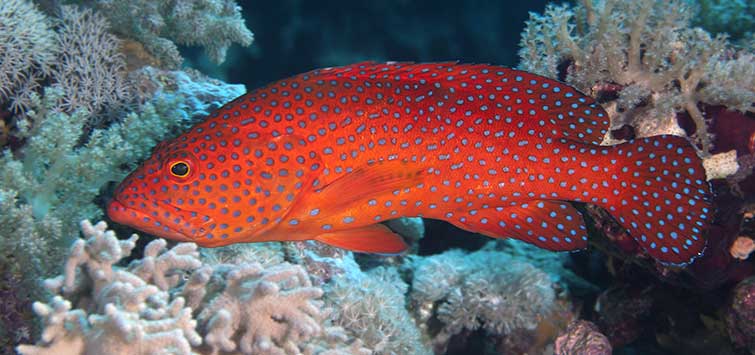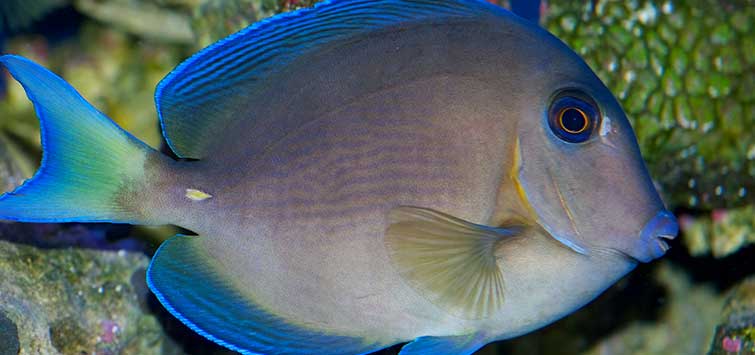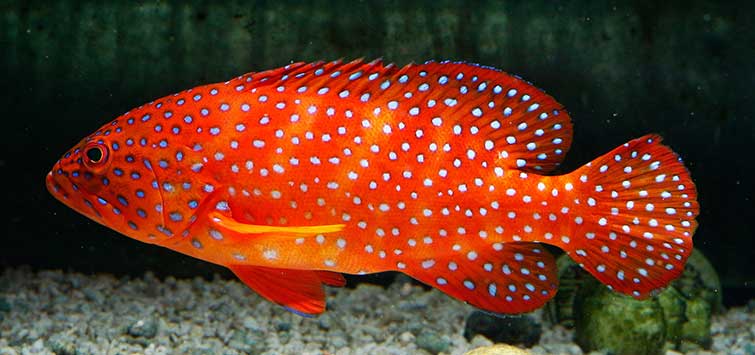A Look at Some Groupers & Hinds
Author: James W. Fatherree
Planning on keeping a grouper in that 75-gallon marine setup? Think again! Some members of the subfamily Epinephelinae grow to several feet long—find out which can be successfully kept, and what their minimum requirements are.
A Look at Some Groupers & Hinds
The family Serranidae contains numerous fishes that can be called sea basses. In fact, there are about 62 genera and 449 species that fit into this clan, with common names that include basses, hamlets, coneys, lyretails, anthias, and more. However, I want to spend some time covering just a few of these that are in the subfamily Epinephelinae, which are most commonly called groupers or hinds. What you’ll see is that while these can be attractive and very hardy fishes, many are also unsuitable for most aquariums.
The Basics
First of all, the names of these fishes can be very different depending on who you’re talking to. Some species of grouper may have three or four common names, and they may also be called hinds as well. For example, the peacock grouper Cephalopholis argus is sometimes called a blue-spotted grouper or argus grouper, but I’ve also seen it called a peacock hind or argus hind. No need to get too worried about common names though, as I’ve provided scientific names for each species of fish that I’ll say anything specific about.
Regardless of their names, what I can tell you about the lot of them is that they’ve been categorically hardy fishes in my experience, and the vast majority of aquarists that have experience with them will agree. These fishes tend to ship well and are apparently as resistant to disease as a marine fish can be. They can also tolerate less-than-perfect water quality (not that you should ever use that as an excuse to slack off on your maintenance duties).
Many are very attractive fishes and can develop distinct personalities, too. It’s quite common for a grouper to be rather shy and skittish when first introduced to an aquarium, but this usually changes over time after they become accustomed to their surroundings and your stares. Afterwards, they’ll generally spend more time in plain view staring back at you and a lot less time hiding in a hole or behind a decoration.
Housing & Feeding
Speaking of holes and decorations, one thing you’ll need to do for most any grouper is provide them with something of a cave to hide in. This is easy enough if you can find some large pieces of base rock, live rock, or artificial corals, etc. Just stack some pieces up in such a way as to build a suitably sized retreat for the fish to hang out in, and do be careful that it isn’t unstable enough to be easily knocked over by its inhabitant. Oftentimes this is exactly where you find them on reefs, as many of the groupers that I’ve watched like to hover under a ledge or overhang or in a cave of some sort, waiting for a meal to come by.
It’s also a good idea to create an additional hangout which is out of sight. This way a new fish can hide itself without having to look at you or be observed until it is ready to do so.
Hunting
While they’ll get out and swim around once comfortable, this sort of hovering-in-one-spot behavior is the norm as best as I can tell. Groupers tend to be ambush predators that wait for something to swim by and get a little too close. They then spring forward, open their mouths wide, and suck up their prey in one big gulp; when a grouper’s mouth is opened quickly, a strong suction is created and in goes anything that’ll fit. Note that their mouths can be exceptionally large too, despite what they look like when closed, as some species can open up their jaws to nearly the same diameter as their whole body.
Diet
That doesn’t mean you have to feed them anything that large though, and I haven’t yet seen a grouper that wouldn’t eventually take non-living food items either. In the wild they’ll eat fishes smaller than themselves, obviously, but they’ll also eat a wide variety of crabs, shrimps, and lobsters, with octopuses and squids on the menu as well. Thus, uncooked chunks or fillets of fish, octopus, or squid will do, as will clam strips, scallops, crab, and shrimp.
Smaller specimens will take krill, silversides, and even brine shrimp and flake foods. And of course, if you so choose, you can give them live fish, shrimp, etc. Do note that you shouldn’t use any sort of freshwater feeder fishes like goldfish or guppies though, as it is thought that they are not good for the health of marine fishes (Toonen, 2001 & 2003). The same goes for feeding with non-living freshwater fish too—use a marine species instead.
This may vary by species, size, and individual, but it’s common for some groupers to go without food for extended periods at times. So don’t be surprised if you add some food and it doesn’t get eaten. It may take a while, but you should eventually be able to get an idea of how much and how often to feed a grouper, and then feed as needed. In the meantime, always be sure to remove any uneaten foods to prevent degradation of the aquarium’s water quality.
The Rest of the Story
So, groupers can be intelligent, personable, attractive, and tough, but that doesn’t mean you should run out and buy one. There are several downsides to grouper ownership, and for the most part, only a dedicated hobbyist that really, really likes them should ever bring one home. Again, they aren’t for everyone, but rather are suitable for few of those interested.
You might have guessed already that their adult size can be a problem for most aquarists, and it is. Just to give you an idea of how big some available groupers can get, I’ve listed the maximum reported sizes of a few species I saw on the stock lists of a couple suppliers.
Grouper Size List
There are other groupers and close cousins available, but these are common enough and will get the point across. Though something to note is that these are the record sizes listed in a database, and this doesn’t mean that every individual of a given species will grow so large. Still, it’s safe to assume that any grouper you put in a large-enough tank and take good care of will likely reach around one-half to two-thirds of the record size at the least. Any specimen could of course be even less than half (a runt fish) or more than two thirds (a real big bruiser) of the record, so this is just a general guideline. Anyway, here are a few different groupers and hinds:
• The Caribbean coney Cephalopholis fulva can reach a full length of about 16 inches.
• The miniata grouper or coral hind Cephalopholis miniata can reach a full length of about 18 inches.
• The spotted grouper, white-spotted grouper, Summan grouper, or speckled-fin grouper Epinephelus summana can reach a full length of about 20 inches.
• The tomato hind Cephalopholis sonnerati can reach a full length of about 22 inches.
• The peacock grouper/hind, blue-spotted grouper, or argus grouper/hind Cephalopholis argus can reach a full length of about 24 inches.
• The panther grouper, spotted grouper, polka-dot grouper, or humpback grouper Cromileptes altivelis can reach a full length of about 28 inches.
• The black-saddled grouper Plectropomus laevis can reach a full length of about 49 inches—good grief!
Yep, that last one, which happens to be one of the best-looking in my opinion, has been known to make it to over 4 feet. Definitely not something you want to add to a normal home aquarium, despite their being offered fairly regularly. Fortunately, the rest aren’t as huge, and if you go by the one-half-to-two-thirds guideline, the first couple on the list may be okay in tanks as small as 150 gallons or so.
I’m sure there’s someone out there right now that has a fairly large, healthy miniata grouper in a 150-gallon tank or something around that size, but my recommendations will always err on the side of more room than is needed, rather than less than what a fish should have. Besides, if you assume that a particular specimen will only reach half to two-thirds of its reported maximum size, Murphy’s Law dictates that it won’t stop there, and you’ll likely end up buying a new tank or losing an old fish. Again, it’s just a general guideline.
So with the exception of the largest species on the list, I say the others, with maximum sizes of 16 inches up to 28 inches, shouldn’t be kept in anything smaller than a 200- to 300-gallon tank, respectively. And that’s if there aren’t too many other fishes, and there’s excellent circulation and filtration to help manage the amount of wastes that a large predatory fish can generate. Now you see why I said they’re not for everyone….
Aggression and Tankmates
And that’s not all. They can also be quite aggressive at times, and you should never try to keep more than one grouper of the same species together in the same tank, or even another similar species. Chances are good that they will never learn to get along, and one will end up killing the other, or both will harass each other to death.
Unfortunately, they can also show aggression towards other non-grouper sorts of fishes if they are similar enough to a grouper and are about the same size or smaller. But I wouldn’t say that’s a common occurrence—triggers, morays, lionfishes, and other such predators should be fine, so long as they are big enough to stay off the grouper’s menu.
Still I’ll add that you’ll have to be sure that any slower-moving fish, like a big lionfish, gets its share at mealtime. A grouper can dash and gulp with surprising speed, and a slow-moving tankmate may miss out on any food added if you don’t take steps to see that they don’t.
Do Your Homework
If you like big tanks and big fishes, then a grouper may be just the thing you’re looking for. But before you pick one up, it is imperative that you do some homework and find out as much as possible about any particular species you may be interested in. After all, there’s a big difference in a potentially 16-inch Caribbean coney and a 49-inch black-saddled grouper, even if they’re sold at the same diminutive size at a shop.
I’ll also add that you need to be careful about where you get your information. I did a few minutes of surfing on the Internet just to see what some of the folks that sell groupers had to say about them on their sites, and some of what I read was downright silly. For example, one site offered panther groupers at a 2- to 3-inch length, listed their care level as easy, and also wrote that they’re peaceful with other fishes their size. Of course, what they didn’t mention is that this species is likely to grow to nearly 20 inches or more if well cared for, and will eat just about anything meaty that’ll fit in its mouth.
The next site I came across did give their full size as 20 inches, but a few lines down they recommended a minimum tank size of 60 gallons! A big panther in a tank that size would barely be able to turn around and certainly wouldn’t be doing much swimming from end to end either. Conversely, the next site I checked also provided their full size as 20 inches, but recommended a 300-gallon tank as the minimum size, said their care level was moderate, and noted that they have an aggressive temperament. Now that’s more like it.
Don’t Put a Big Fish in a Little Tank
So you get the idea now. You can easily look up the full size of any aquarium fishes at FishBase (www.fishbase.org), and use some common sense when it comes to choosing the proper tank size. You don’t need to be a rocket scientist to figure out that even a 10-inch fish isn’t going to be too happy in a 60-gallon tank. Yes, a smaller tank will indeed be fine if you purchase a small specimen, but only temporarily—then the day will come when you must either buy a much bigger tank, or find a new home for your growing grouper. These are just some things to think about.
References and Resources
Fenner, R. “The Basses, Family Serranidae.” Wet Web Media. www.wetwebmedia.com/basses.htm.
Toonen, R. 2001. “Invert Insights” Tropical Fish Hobbyist (October 2001). pp. 94–99.
Toonen, R. 2003. “Nutritional Value of Live Foods for the Coral Reef Aquarium.” Advanced Aquarist’s Online Magazine. www.advancedaquarist.com/issues/dec2003/invert.htm.
See the full article on TFH Digital http://www.tfhdigital.com/tfh/200806/#pg113




